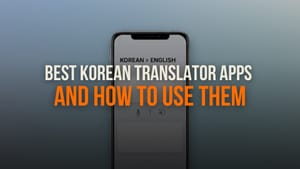If you’ve watched Fight For My Way or School 2017, you’ve probably seen those moments where characters suddenly switch into their cute mode — tilting their heads, puffing their cheeks, or using a high-pitched voice to melt hearts (and sometimes to get their way). That’s what we call Korean aegyo!
In this guide, I’ll share everything you need to know about Korean aegyo — what it really means, why it’s such a big part of Korean culture, and how you can pull it off without feeling awkward or over the top. Whether you want to sound adorable when speaking Korean or just understand why your favorite idol acts cute on camera, this is your go-to breakdown of how to do aegyo right.
- Best Way To Learn Korean: A Guide For Beginners
- 12 Korean Myths And Legends Everyone Learning Korean Should Know
- 15+ Korean Insults That Won’t Get You Slapped (Probably)

What Is Korean Aegyo (애교)?
Korean aegyo (애교) means acting, speaking, or gesturing in a cute and charming way to express affection or soften communication. It often involves baby-like speech, high-pitched tones, and playful gestures such as pouting or forming finger hearts.
The word 애교 literally translates to “charming behavior.” Its purpose is to show affection, make requests sound gentler, or bring a playful tone to interactions. Aegyo is common among couples, friends, and entertainers, and it reflects a broader cultural value of maintaining harmony and approachability.
Similar to Japan’s kawaii culture or China’s sājiāo, Korean aegyo stands out for its blend of innocence, humor, and emotional connection.
Why Do People Use Aegyo (애교)?
People use aegyo (애교) to express affection, make requests sound softer, or create a light and friendly atmosphere. In a culture that values politeness and emotional warmth, aegyo helps people connect without sounding demanding or cold.
While anyone can do aegyo, it’s more commonly associated with women and often carries a slightly flirtatious tone. Female idols and drama characters use aegyo to appear charming or lovable, while men might use it more sparingly, usually in joking or romantic contexts. This gendered expectation reflects how Korean aegyo blends cultural ideas of softness, humor, and subtle flirtation.

How To Do Korean Aegyo
To do Korean aegyo, focus on using a cute, upbeat voice, soft speech patterns, and playful gestures. Each element adds a layer of charm and expressiveness. Here’s how to get it right.
Adjust Your Voice
Your tone sets the foundation for aegyo. Raise your pitch slightly (about an octave higher than usual) and speak with a light, bouncy rhythm. Think of how someone might talk to a pet or a close friend when being extra affectionate. Keep your volume gentle but bright, as if your words are bouncing. The goal is to sound warm and playful, not overly childish.
Try recording yourself to find a tone that feels bright without becoming exaggerated. If you’ve watched K-pop idols or variety shows, you’ll notice that idols often tilt their heads and speak in a higher register when doing aegyo — that’s exactly the vocal texture you’re going for.
Stretch The Final Vowels
A signature trait of aegyo speech is elongating vowel sounds at the end of words. This adds a childlike, melodic rhythm. For instance, 안녕 (annyeong) might become 안뇽~ (annyong~), or 오빠 (oppa) turns into 오빠아~ (oppaaa~). This stretched pronunciation gives the impression of a gentle whine or plea, which is central to the cuteness of aegyo.

Add An Ieung (ㅇ) Or Mieum (ㅁ)
Another classic aegyo technique is ending words with a soft ng (ㅇ) or m (ㅁ) sound. This creates a rounded, baby-like pronunciation that feels cozy and cute.
For example:
- 오빠 (oppa) → 오빵 (oppang)
- 배고파 (baegopa / I’m hungry) → 배고팡 (baegopang)
- 어디야 (eodiya / where are you?) → 어디얌 (eodiyam)
It’s common in texting and online chat, too. These endings soften your words and signal playfulness and affection rather than seriousness.
Use Common Aegyo Words And Phrases
Certain Korean words and expressions are frequently used in aegyo. You can modify standard phrases by adding cute suffixes or sounds like “~앙 (~ang)” or “~용 (~yong)” to create playful variations. Below is a table showing some common examples of how regular expressions transform into their aegyo versions.
| Standard Korean | Aegyo Version | Meaning (in English) |
|---|---|---|
| 오빠 (oppa) | 오빵 (oppang) | “Older brother” or boyfriend, said cutely |
| 보고싶어요 (bogosipeoyo) | 보고싶어용 (bogosipeoyong) | “I miss you” in a cute way |
| 뭐해요? (mwohaeyo?) | 뭐해용? (mwohaeyong?) | “What are you doing?” with a playful tone |
| 사랑해요 (saranghaeyo) | 사랑해용 (saranghaeyong) | “I love you” said adorably |
| 안녕 (annyeong) | 안뇽 (annyong) | “Hi/Bye” in aegyo style |
Using these phrases adds instant cuteness to casual interactions. The suffixes “~용” and “~앙” are the most common, and they soften the speech to sound friendly and teasing rather than formal or serious.

Practice Aegyo Gestures
In Korean culture, cute gestures help enhance your words and make your aegyo actions match your tone. You can try the 손하트 (son hateu), or finger heart, made by crossing your thumb and index finger. Here are other popular KOrean aegyo gestures:
- Finger Heart (손하트): Cross your thumb and index finger to form a tiny heart shape. Widely used by K-pop idols, instantly recognizable.
- Cheek Heart (볼하트): Gently press bent fingers to your cheeks, creating heart shapes or emphasizing “cute cheeks.”
- 뿌잉뿌잉 (Bbuing-bbuing): A classic exaggerated aegyo gesture — fists by cheeks, pouty face, playful “bbuing bbuing” sound. Flags a humorous, intentionally over-the-top cute act.
- Flower Pose (꽃받침): Resting your chin on your palms, wrists touching, giving a “flower under the face” look. Soft, less extreme, and good for pictures or casual cute mode.
- Texting/Typing Gestures: Even in chats you’ll find aegyo through emoticons, accented endings, repeated letters, and extra vowels. E.g., 밥 먹었옹? instead of 밥 먹었어?
Use Aegyo Naturally
True aegyo doesn’t feel forced. It should come across as spontaneous, warm, and sincere. Try practicing in comfortable, casual settings with people you trust, such as close friends, partners, or family. Remember that aegyo is meant to be lighthearted and fun — overdoing it might feel awkward or insincere.
Focus on smiling with your eyes, speaking with gentle warmth, and allowing moments of genuine playfulness to shine through. The goal is not to act like someone else, but to bring out a cute, more affectionate version of yourself. When done naturally, aegyo becomes a way of expressing charm, care, and confidence effortlessly.
Keep Learning Korean the Fun Way
If reading about aegyo sparked your curiosity about Korean culture and language, take it a step further with Lingopie. It’s a streaming platform that lets you learn Korean by watching real K-dramas, movies, and shows with interactive subtitles. You can click on any word, hear its pronunciation, and even add it to your study list while watching your favorite scenes.
Lingopie makes it easy to absorb natural Korean expressions and tones—the same kind of speech and gestures that make aegyo so charming. If you want to learn how Koreans really speak, laugh, and express themselves, give Lingopie a try and start learning straight from the screen.


![Korean Aegyo: Korean Words And Gestures To Look And Sound Cute [2025]](/blog/content/images/size/w1200/2025/10/Korean-agyeo.png)

![Spanish Day Of The Dead: Traditions & Vocab Guide [2025]](/blog/content/images/2025/10/spanish-day-of-the-dead-2.jpg)



![How To Speak Korean: Classes, Apps, And Immersion Tips [2025]](/blog/content/images/size/w300/2025/10/how-to-speak-korean-2.jpg)
